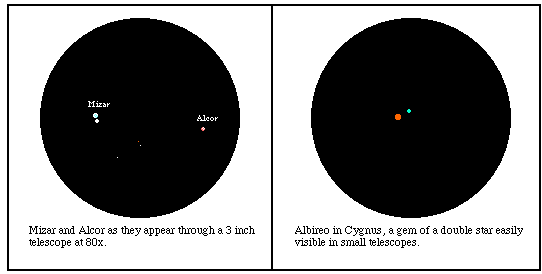
A surprising number of stars have turned out to be members of binary or multiple systems. Some of these are visible in small telescopes, and a few make for very pretty views due to contrast or position. Double stars are usually bright compared to deep sky objects, and thus are easier to find and less affected by light pollution. The challenge lies in resolving or splitting the components. The larger the aperture and the better the optics, the better your chances will be. Use fairly high magnification to reduce glare and put space between the stars. Many double stars are showcases in even the smallest, cheapest telescopes. The Double Star Database contains a listing of quite a few interesting pairs and groups.
After Mizar, the next double star a beginner should check out is Albireo, in the "head" of Cygnus the Swan. Albireo appears to the naked eye as a single 3rd magnitude star, but in a 2 inch telescope it is easily split into two stars. One component is orange and the other is blue, at least to my eyes. Different observers may see different colors. Some people have told me the stars are yellow and green, or white and red. Take a look for yourself.

There are a few standout systems that contain three or more stars visible through small telescopes. The most famous of these is Epsilon Lyrae, the "Double Double". It is quite a challenge for the naked eye to separate this into two stars. A good eye combined with a telescope and a steady atmosphere can split each of these stars into two. On some nights, I have managed to see all four stars in a 2.5 inch telescope with 80x magnification. On nights when the atmosphere is not as steady, one can fail to split them with an 8 inch scope.
Many double stars appear single through any telescope. A few of these are of interest to visual astronomers because the stars eclipse each other. When the fainter star eclipses the brighter one as seen from Earth, the light we receive from the star system drops and the star appears fainter. These eclipsing binaries are one of many classes of variable stars. Algol, a fairly bright star in the constellation Perseus, is the best-known eclipsing binary. It has a period of about three days. Algol is usually bright, but for a span of a few hours it dims to less than 1/3 its normal brightness. Times of these minima can be found in each month's Sky and Telescope magazine.
Larger groups of stars can also be seen in our sky; many of them fall into the class of deep-sky objects.